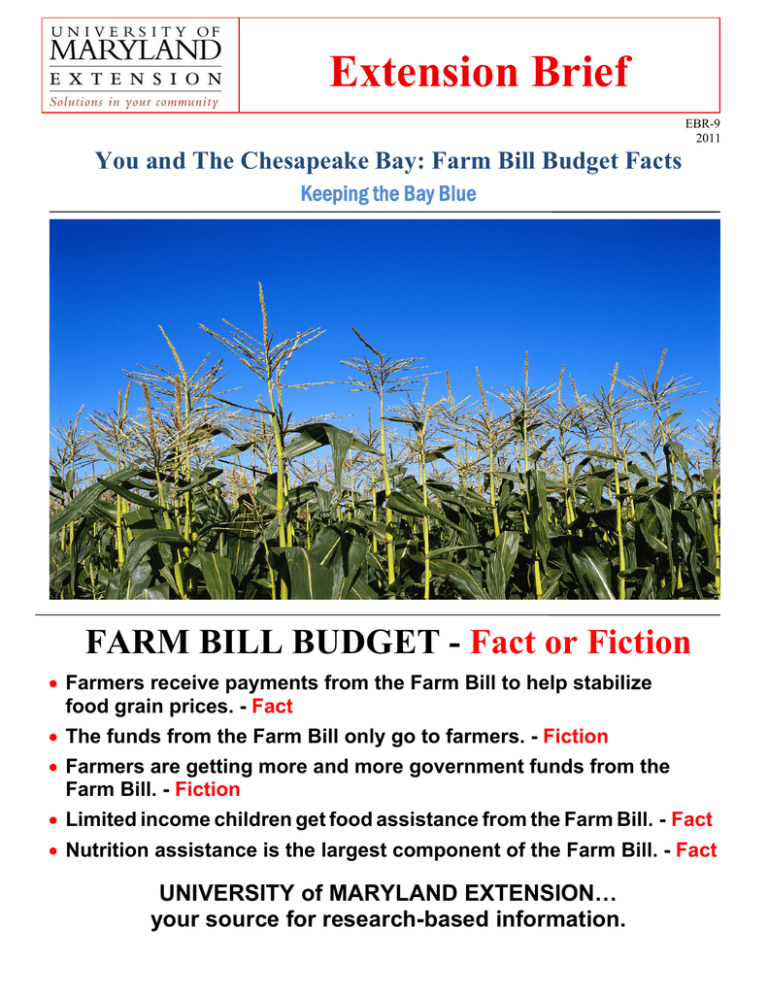
Extension Brief
EBR-9
2011
You and The Chesapeake Bay: Farm Bill Budget Facts
Keeping the Bay Blue
FARM BILL BUDGET - Fact or Fiction
• Farmers receive payments from the Farm Bill to help stabilize
food grain prices. - Fact
• The funds from the Farm Bill only go to farmers. - Fiction
• Farmers are getting more and more government funds from the
Farm Bill. - Fiction
• Limited income children get food assistance from the Farm Bill. - Fact
• Nutrition assistance is the largest component of the Farm Bill. - Fact
UNIVERSITY of MARYLAND EXTENSION…
your source for research-based information.
FARM BILL BUDGET FACTS
United States Department of Agriculture
USDA
USDA FY 2012
BUDGET OUTLAYS
$145 BILLION
FARM & COMMODITY
PROGRAMS
2012
$18.85B
FARM & COMMODITY
PROGRAMS
2004
$17.94B
Nutrition Assistance Programs
No one should go hungry in America. United States Department of Agriculture Food and Nutrition Service
(FNS) provide children and low-income people access to food, a healthful diet, and nutrition education. They
help nearly one in five people. These FNS programs include:
• Supplemental Nutrition Assistance Program (formerly the Food Stamp Program)
• Women, Infants and Children
- Farmers' Market Nutrition Program
- Senior Farmers' Market Nutrition Program
• School Meals
- National School Lunch Program
- School Breakfast Program
- Team Nutrition
•
•
•
•
- Fresh Fruit & Vegetable Program
- Special Milk Program
Summer Food Service Program
Child and Adult Care Food Program
Food Assistance for Disaster Relief
Food Distribution
- Schools/Child Nutrition Commodity Programs
- Nutrition Services Incentive Program
- The Emergency Food Assistance Program
- Food Distribution Program on Indian Reservations
- Commodity Supplemental Food Program
Contact: www.extension.umd.edu or call your local University of Maryland Extension Office.
You and The Chesapeake Bay: Farm Bill Budget Facts
Keeping the Bay Blue
Authored by:
Jenny Rhodes, UME, Queen Anne’s Co., Shannon Dill, UME, Talbot County, John Hall, UME, Kent County
Reviewed by:
Charles C. Cawley, State Executive Director, USDA Farm Service Agency, Maryland State Office, Annapolis, MD
Wesley Musser, University of Maryland Professor & Extension Specialist, Farm Management, Ag & Resource Economics
Issued in furtherance of Cooperative Extension work, acts of May 8 and June 30, 1914, in cooperation with the U.S. Department of
Agriculture, University of Maryland, College Park, and local governments. Cheng-i Wei, Director of University of Maryland Extension.
The University of Maryland is equal opportunity. The University’s policies, programs, and activities are in conformance with pertinent
Federal and State laws and regulations on nondiscrimination regarding race, color, religion, age, national origin, gender, sexual
orientation, marital or parental status, or disability. Inquiries regarding compliance with Title VI of the Civil Rights Act of 1964, as
amended; title IX of the Educational Amendments; Section 504 of the Rehabilitation Act of 1973; and the Americans With Disabilities Act
of 1990; or related legal requirements should be directed to the Director of Human Resources Management, Office of the Dean, College of
Agriculture and Natural Resources, Symons Hall, College Park, MD 20742.


